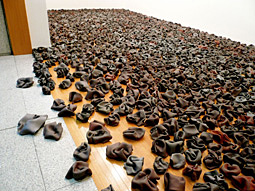 |
|
 |
Kino-Niku, Tsuchi-no-Ha, 1991
Courtesy: Takamatsu City Museum of Art |
|
Tananmentai (Soft Polyhedrons), 2009
Courtesy: Artist |
|
|
Unlike painters or photographers whose most basic materials are supplied to them, the ceramicist begins with the essentials of physical life: stone, soil, and water. In his seventies, Kosho Ito creates works defined by their search for the primordial character of materials and harmony arising from principles of nature and the ceramic medium.
Ito's work examines the natural world through a dialogue between organic and inorganic nature. Rather than a scientific determination of molecule and atoms, Ito has holistically distilled the material's essential plastic form. The materials he uses could be in no more essential a form than that which Ito has exposed.
Although Ito's work is often exposed to natural elements, it resists the kind of dialogue with organic nature that the methods of landscape art emphasize, as in the work of Richard Long. Whereas Long's work takes as imperative the incorporation of materials of the region, it is the reverse for Ito. Instead of basing his materials in the natural environment, using things that decay, erode and eventually return to the natural world outside the studio, Ito has created a dialogue with the natural world within the materials themselves -- aiming not outward, like the interrelationships of an ecosystem, but inward, toward the forms within the material's intrinsic natural harmony.
Nearly all of Ito's works are composed of similar objects displayed en masse and bearing a deliberate lack of the artist's imprint. Due to their untouched nature and multitudinous placement, the objects evoke the harmony of things in nature without eliminating individual variations. Just as no two grains of sand are identical, Ito emphasizes this autonomy by placing some pieces such that they appear to have a will of their own, slowly edging out of the space as in "Tananmentai," "Seafolds" or "Feldspar."
From the mixed acrylic shine and matte themes of the "Chromatics" series to the wavering vertical planes of "Ki-no-Niku, Tsuchi-no-Ha" (Flesh of Tree, Blade of Dirt), all shapes appear to have developed through their own natural processes, like crystal formation, erosion, or bone growth. In one aspect, the aesthetic of natural formation is reminiscent of the organic cycle, but Ito's work lacks a truly organic aspect in that everything appears as distilled slices of a total spectrum. Thus however minimized the artist's hand may be, the artistic process remains the focal point. The process of firing itself is captured, producing a sterile and scientific appearance, like a dissected or microscopic view of the artistic process, as in "Fired Frozen Clay" or "Folds of Clay - Blue Freeze."
The 1984/2009 work "Eros of Alumina (White Solidities are...)" fills the cavernous main gallery. The material used, alumina, is a hard, abrasive substance with a high melting point and neutralizing white refractivity, and has been fired to varying degrees of disintegration. Arranged in a bright circle on the floor of the gallery, the work unmistakably triggers images of a nuclear blast site: outwardly radiating rings and square, building-like shapes. Rather than the blackened aftermath of destruction, however, Ito has captured the split-second of the flash in view-encompassing 3D, providing a space of enduring contemplation, something unattainable photographically but rendered here through texture, light and space.
This retrospective presents not only Ito's thorough investigation into materials, but his endeavor to convey the primacy of the medium and its conceptual relationship to one who works with the elemental building blocks of an earth-bound existence.
|